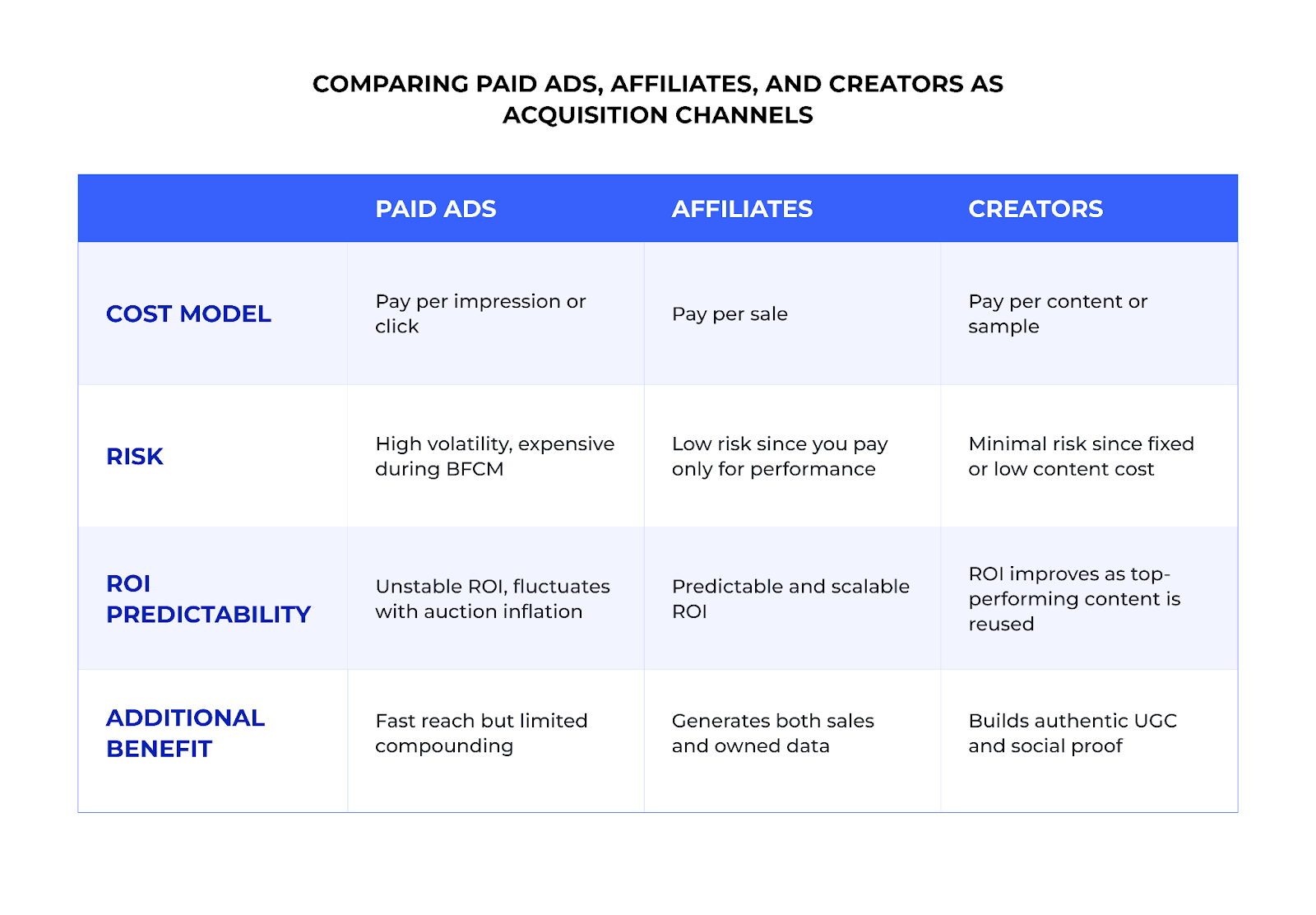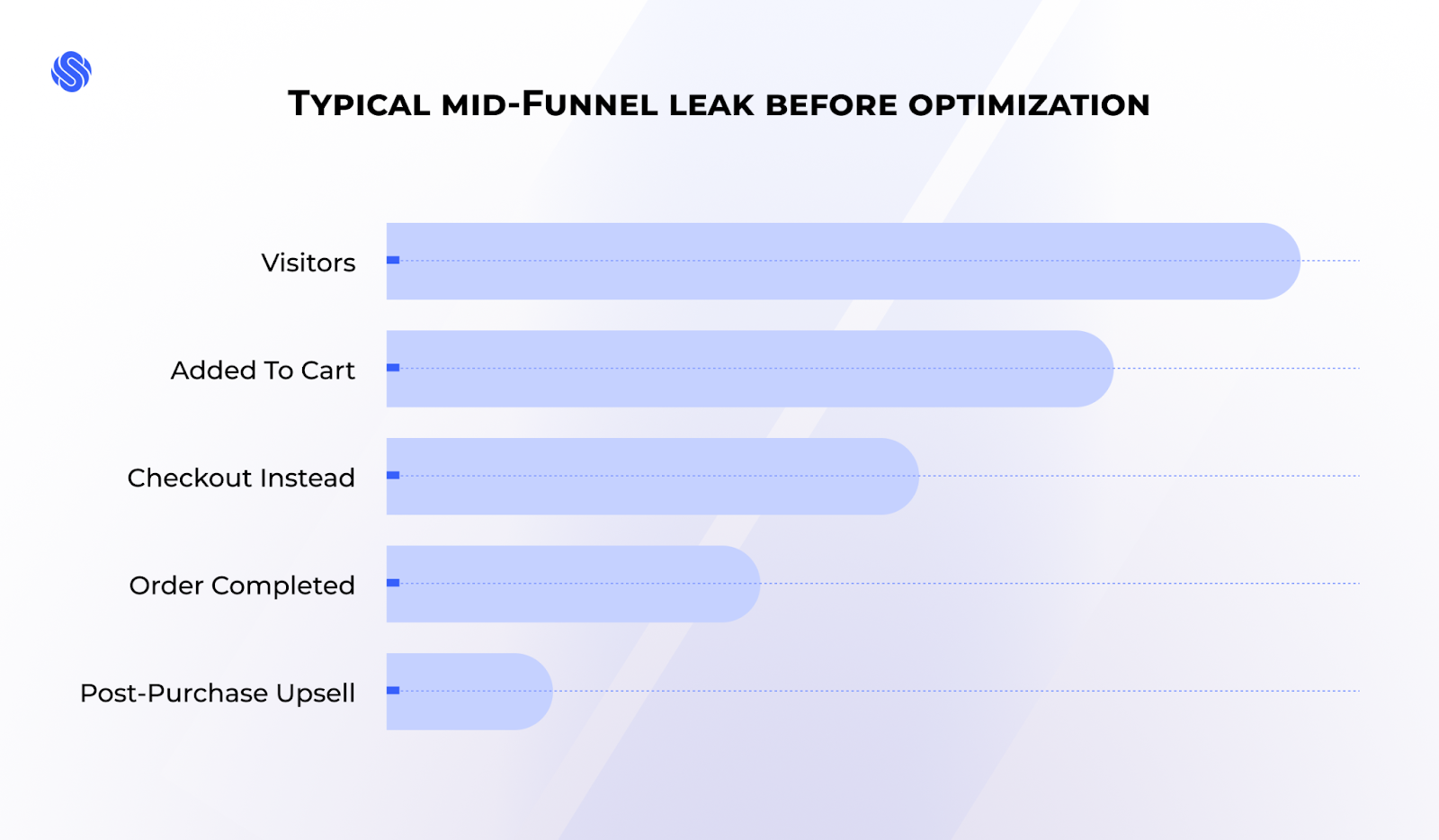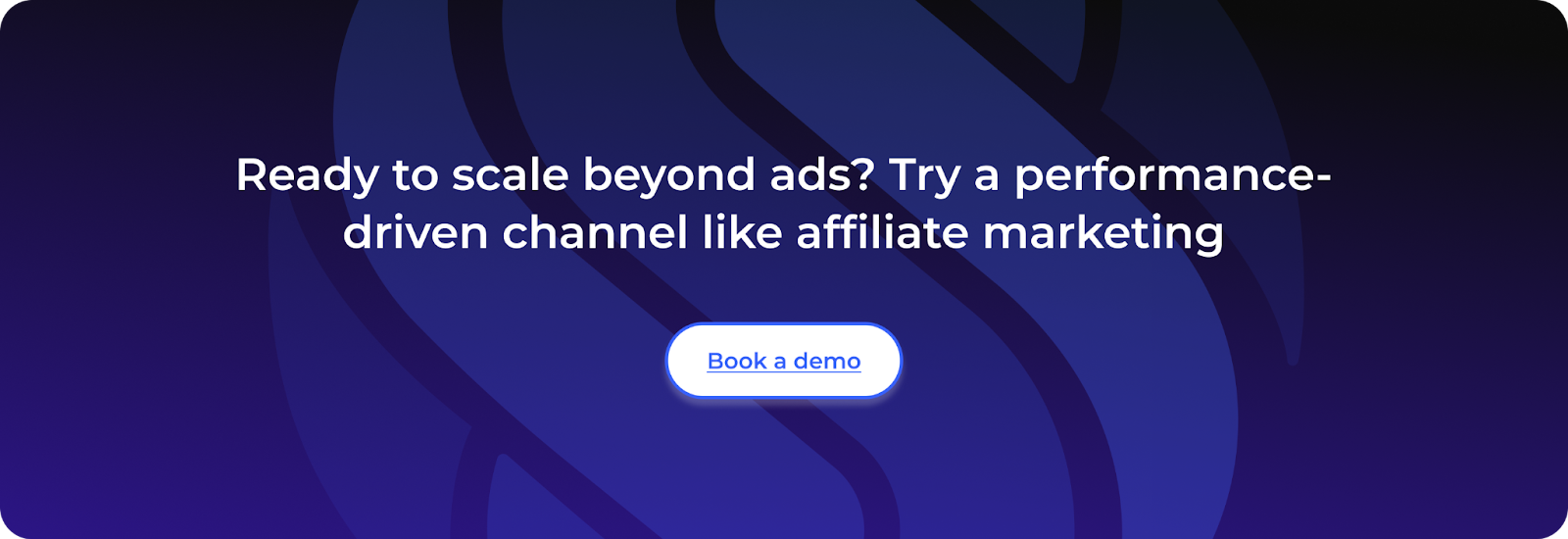Every BFCM season, ad spend skyrockets, inboxes overflow, and competition intensifies. Yet, even as more brands double down on paid ads, the ones consistently winning are those who have learned to grow beyond them.
This year, ad costs are hitting record high, and privacy shifts are making attribution murkier than ever, turning overdependence on ads into a major risk.
To understand what sustainable acquisition looks like heading into Q4, we spoke to three performance leaders shaping how top ecommerce brands approach growth: Jonathan Gosper (President at Evestar), Rabii Babou (CEO at Livano), and Jordan West (CEO at Social Commerce Club).
Their shared insight? The most successful BFCM DTC playbooks will blend performance, community, and creator ecosystems into one cohesive growth engine.
Let’s unpack what they have to say in detail.
The problem with ad dependence
Ad-heavy strategies can scale fast, but they crumble just as quickly under pressure.
“The main risk is exploding CAC from auction inflation,” said Gosper. “We’ve tracked CPMs jumping 50–70% on platforms like Meta and Google, squeezing margins under 10% for weak campaigns.”

Babou added that this volatility leaves brands trapped in a “pay-to-play” cycle:
“Paid media costs spike dramatically during BFCM, and CPMs can double or triple. Without a backup channel like affiliates or creators, brands are completely exposed to platform volatility.”
Jordan West also emphasised on the need for owned lists.
“BFCM should convert a warmed-up list, not try to build one on the fly at the most expensive time of the year.”
The consensus: Treating paid ads as your only acquisition lever creates instability when you need reliability the most.
Why owned channels are still your best bet for high ROI
When acquisition costs rise, owned channels like email, SMS, and community become a brand’s biggest competitive advantage.
“At Evestar, we’ve watched DTC brands in fashion and wellness dominate BFCM with hyper-personalized email and SMS flows built on zero-party data,” said Jonathan Gosper. “With Klaviyo’s AI segmentation, abandoned cart recovery and loyalty unlocks drive 3–4x LTV boosts without touching ads.”
He added that layering SMS into the mix drives even faster results. “With Postscript, brands capture verified opt-ins at checkout and through onsite popups, then trigger high-converting SMS flows that drive immediate action during BFCM. Some clients see 25–30% of BFCM revenue come straight from SMS-driven engagement.”
Gosper also emphasized that the best results come from full-funnel retention strategies, not just pre-purchase flows. “Post-purchase automation—like loyalty unlocks or win-back offers—extends that LTV curve,” he said. “The goal is to make every buyer a repeat buyer by default.”
With his clients, Jordan West takes that a step further, using exclusivity to drive organic conversions.
“A gated launch (password-protecting your site, limiting access to VIPs via SMS or your community) creates massive FOMO and requires zero ad spend. We tell VIPs they can share the password with two friends, and it spreads organically.”
This sense of exclusivity doesn’t just lift conversion rates; it builds lasting engagement. By turning email lists, SMS subscribers, and VIP members into an inner circle, brands create emotional buy-in that keeps working long after the BFCM rush ends.
As Gosper summarized, “Email remains a cornerstone of high-ROI growth. Behavioral segmentation and automation flows turn retargeting into real revenue.”
Affiliates and creators: The low-risk growth engine
While owned channels protect your margins, affiliates and creators expand your reach, without the risk that comes with ad-heavy campaigns.
“Paid media should amplify what’s already working, not be the sole driver,” said Rabii Babou, CEO at Livano. “Affiliates, TikTok Shop, and ambassador programs create evergreen sales engines that keep performing long after BFCM ends.”
He added that the smartest play is to turn customers and creators into your salesforce. “You can recruit affiliates who only earn when they sell,” Babou explained. “It gives you predictable ROI while flooding the platform with authentic content.”
This performance-first model works especially well for smaller brands with limited budgets. “On TikTok Shop, you can lock in micro-creators for as little as $10 per video plus commission,” Babou said. “You guarantee content volume, keep costs low, and maintain consistent reach.”
Jordan West sees affiliate and creator programs as a strategic offset to rising CAC. “We build an affiliate and creator army through TikTok Shop,” he said. “We line up bundles they can sell and whitelist top-performing videos. It meaningfully offsets acquisition costs.”
Beyond the financial efficiency, these programs deliver creative and compounding benefits that ads can’t.
“Even when affiliates don’t drive immediate conversions, they’re flooding the platform with authentic content that builds trust,” Babou said. “That content often outperforms paid creative when reused in ads or landing pages.”
The beauty of this model lies in its compounding returns. Even when affiliates don’t convert immediately, brands still gain UGC and organic exposure that fuels future campaigns.
“Affiliate marketing is inherently low-risk,” Babou said. “You always win, either through sales or content.”

Fixing the funnel before the rush

Paid ads can only amplify what’s already working. That’s why on-site optimization is critical before BFCM.
“Post-add-to-cart friction is often ignored,” said Gosper. “We’ve seen mobile checkouts alone cause 40% drop-offs from bad UX like clunky forms or buried shipping calculators.”
Here’s how to fix the funnel before the BFCM rush:
- Eliminate post-add-to-cart friction: Audit checkout flows for UX blockers like clunky forms, buried shipping calculators, or forced account creation. These can cause up to 40% mobile checkout drop-offs.
- Use AI to speed up conversions: Implement predictive autofill tools to streamline checkout and add one-click upsells to boost average order value by 15–20%.
- Test and refine early: Run multivariate A/B tests on key pages (product, cart, and checkout) at least 4–6 weeks before BFCM. Test elements such as pricing badges, social proof, and layout simplicity.
- Track real user behavior: Use heatmaps to identify where shoppers drop off and fix friction points before scaling paid traffic.
- Prioritize progressive disclosure: Reveal form fields or extra options only when needed to simplify the path to purchase. Gosper reports this alone can cut bounce rates by 25%.
- Measure ROI of UX changes: Compare pre- and post-test conversion rates to ensure optimizations drive 3–5x better ad efficiency during peak traffic weeks.
“Brands skipping this mid-funnel fix waste 30% of traffic, turning BFCM rushes into lost profits,”
According to Jordan West, the timing of your campaigns matters as much as the funnel itself:
“Don’t cram everything into one weekend. Stretch the window and rotate offers that solve problems, not just price cuts. Bundles that fix a gifting dilemma win every time.”
The lesson: the most profitable BFCM campaigns aren’t just the loudest, but the smoothest. Brands that clean up conversion friction, test iteratively, and plan their campaign timing early turn every ad dollar and affiliate click into actual margin.
Diversifying creative and channel strategy
Creative fatigue is one of the quietest profit-killers during BFCM.
According to Jonathan Gosper, too many brands rely on a single “hero” creative and push it until results drop off. “Ad frequency above five to seven can reduce click-through rates by up to 50%,” he said. “If your creative rotation lags behind your budget increases, performance nosedives just when competition peaks.”
Diversification, however, isn’t just about producing more content. It’s about appealing to different buying psychologies.
“Urgency-driven ads attract impulse buyers, while bundle-based or problem-solving messaging resonates with more deliberate shoppers. Mixing these angles keeps campaigns fresh across segments.”
Babou added that diversification should extend beyond creatives to include channels.
“Paid media should amplify what’s already working, not be the sole driver. Affiliates, TikTok Shop, and ambassador programs create evergreen sales engines that keep performing long after BFCM ends.”
Jordan West, CEO at Social Commerce Club, views community and VIP programs as creative channels in their own right.
“Community-led drops and loyalty windows outperform expectations. They create emotional buy-in that no ad can replicate.”
West added that this emotional connection compounds over time. “When people feel part of something exclusive, they show up more, convert faster, and bring others along,” he said. “That kind of loyalty builds momentum long after the sale ends.”
In short: diversifying your creative mix isn’t about volume. It’s about strategy. Brands that rotate messaging styles, activate multiple channels, and cultivate communities build resilience against ad fatigue and rising costs. Instead of chasing short-term reach, they build long-term engagement that keeps performing long after BFCM ends.
Testing, iteration, and timing
If there’s one theme the experts agreed on, it’s that great BFCM campaigns aren’t built in November. They’re tested months in advance.
“Kick off multivariate A/B tests on product pages, pricing badges, and checkouts weeks before BFCM. We’ve cut bounce rates 25% with progressive disclosure and clear form design.”
Testing isn’t just about conversion. It’s about knowing when and how to spend. “If CPMs spike and frequency starts hammering existing customers, I pull back,” Gosper noted. “It’s better to front-load spend before BFCM to grow the list, then let owned and affiliate channels carry the weight when costs surge.”
The most effective brands treat BFCM as an ongoing experiment, not a one-time sprint. By testing early, adjusting ad pacing, and letting automation and affiliate channels sustain momentum, they turn volatility into advantage, driving steady growth while others chase short-lived spikes.

Building for long-term growth
Beyond short-term revenue, these experts shared one unifying belief: the strongest brands treat BFCM not as a sprint, but as a systems check for sustainable growth.
“BFCM is where cracks in your strategy become visible,” says Babou. “If you rely solely on paid ads, you’ll feel it immediately. But if you’ve built creator pipelines, affiliate programs, and strong retention flows, you’ll scale effortlessly.”
Jonathan Gosper agreed that resilience comes from investing in data and retention. “Data-rich retention beats ad-driven acquisition every time,” he said. “When you’ve built the right systems (email, SMS, loyalty) you don’t have to outspend competitors to win.”
Or as Jordan West summarized it: “Paid media fuels momentum, but the real engine is what keeps working after the sale, community, content, and connection.”
Actionable checklist for BFCM growth
Break free from ad dependence
- Audit ad performance and cut channels delivering under 10% margins.
- Cap BFCM ad spend at last year’s profitable CAC levels.
- Launch affiliate, creator, and community channels before November.
- Balance paid, owned, and earned media to avoid “pay-to-play” risk.
- Focus paid campaigns on retargeting and list reactivation, not cold traffic.
Strengthen owned channels for reliable ROI
- Personalize email and SMS flows using AI-driven segments.
- Launch loyalty and VIP programs with early access or stackable perks.
- Run gated launches to build exclusivity and organic FOMO.
- Automate cart recovery, browse abandonment, and win-back flows.
- Encourage referrals to grow your list through trusted connections.
Turn affiliates and creators into a growth engine
- Auto-enroll customers as affiliates using Social Snowball.
- Define commission tiers and performance deadlines clearly.
- Seed products early to creators posting gift guides or hauls.
- Partner with micro-creators ($10/video + commission) for content scale.
- Repurpose creator content across ads, landing pages, and emails.
- Treat affiliates as a sales army that earns only when they sell.
Fix your funnel before the rush
- Simplify checkout UX to reduce form friction and drop-offs.
- Add predictive cross-sells and one-click upsells to lift AOV.
- Use heatmaps to spot and fix high-exit friction points.
- Apply progressive disclosure to shorten the path to purchase.
- Turn thank-you pages into referral or loyalty touchpoints.
Diversify your creative and channel mix
- Rotate ad creatives once frequency exceeds 5–7.
- Mix urgency-driven offers with bundle or problem-solving angles.
- Position bundles as gifting or starter solutions, not discounts.
- Activate affiliates, TikTok Shop, and ambassador channels year-round.
- Use community-led drops to drive emotional engagement and loyalty.
Test, iterate, and time your launch
- Run A/B tests on key pages and checkout flows by October.
- Track conversion lifts and bounce rate improvements.
- Front-load ad spend to grow owned audiences before BFCM week.
- Use automation and affiliate programs to sustain momentum during peaks.
Build for long-term growth
- Identify where your engine relies too heavily on paid media.
- Strengthen email, SMS, and loyalty systems for post-BFCM retention.
- Keep top affiliates and creators active beyond the holidays.
- Track repeat purchase rates, creator ROI, and long-term CAC trends.
- Treat BFCM as a stress test to fine-tune growth systems for Q1.
Ready to scale beyond paid ads this BFCM?
This year, the brands that win BFCM won’t be the biggest spenders. They’ll be the ones with smarter, more resilient growth systems. That means investing in owned channels, creator-led sales, and performance-based affiliate programs that reward results, not ad spend.
That’s where Social Snowball helps. The platform enables ecommerce brands to turn their customers and creators into revenue-driving affiliates, automate commissions and payouts, and unify insights across Shopify and TikTok Shop, making it simple to act on the very strategies these experts recommend.
In a season defined by rising CAC and short attention spans, sustainable growth comes from relationships, not just reach.


.png)


.webp)





